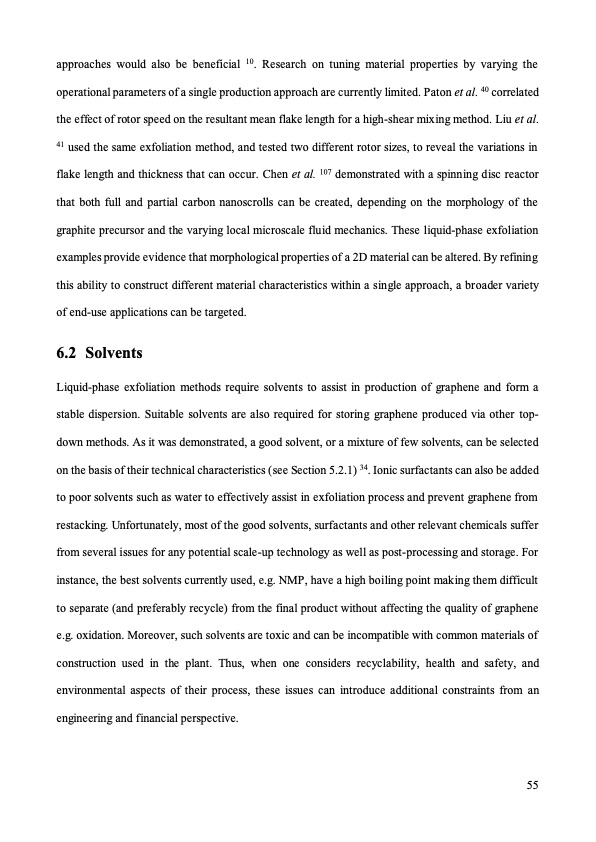
PDF Publication Title:
Text from PDF Page: 055
approaches would also be beneficial 10. Research on tuning material properties by varying the operational parameters of a single production approach are currently limited. Paton et al. 40 correlated the effect of rotor speed on the resultant mean flake length for a high-shear mixing method. Liu et al. 41 used the same exfoliation method, and tested two different rotor sizes, to reveal the variations in flake length and thickness that can occur. Chen et al. 107 demonstrated with a spinning disc reactor that both full and partial carbon nanoscrolls can be created, depending on the morphology of the graphite precursor and the varying local microscale fluid mechanics. These liquid-phase exfoliation examples provide evidence that morphological properties of a 2D material can be altered. By refining this ability to construct different material characteristics within a single approach, a broader variety of end-use applications can be targeted. 6.2 Solvents Liquid-phase exfoliation methods require solvents to assist in production of graphene and form a stable dispersion. Suitable solvents are also required for storing graphene produced via other top- down methods. As it was demonstrated, a good solvent, or a mixture of few solvents, can be selected on the basis of their technical characteristics (see Section 5.2.1) 34. Ionic surfactants can also be added to poor solvents such as water to effectively assist in exfoliation process and prevent graphene from restacking. Unfortunately, most of the good solvents, surfactants and other relevant chemicals suffer from several issues for any potential scale-up technology as well as post-processing and storage. For instance, the best solvents currently used, e.g. NMP, have a high boiling point making them difficult to separate (and preferably recycle) from the final product without affecting the quality of graphene e.g. oxidation. Moreover, such solvents are toxic and can be incompatible with common materials of construction used in the plant. Thus, when one considers recyclability, health and safety, and environmental aspects of their process, these issues can introduce additional constraints from an engineering and financial perspective. 55PDF Image | graphene production via nonoxidizing liquid exfoliation

PDF Search Title:
graphene production via nonoxidizing liquid exfoliationOriginal File Name Searched:
Graphene-R2-review.pdfDIY PDF Search: Google It | Yahoo | Bing
Salgenx Redox Flow Battery Technology: Power up your energy storage game with Salgenx Salt Water Battery. With its advanced technology, the flow battery provides reliable, scalable, and sustainable energy storage for utility-scale projects. Upgrade to a Salgenx flow battery today and take control of your energy future.
| CONTACT TEL: 608-238-6001 Email: greg@infinityturbine.com | RSS | AMP |